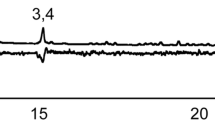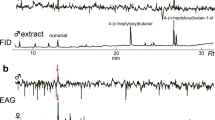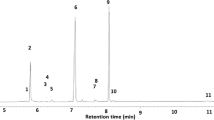Abstract
It was previously reported that males of the crucifer flea beetle, Phyllotreta cruciferae, feeding on host foliage are attractive to both males and females in the field. Based on this evidence for an aggregation pheromone, volatiles were collected from male and female P. cruciferae feeding on cabbage (Brassica oleracea) and analyzed. For comparison, volatiles were also collected from males and females of three other flea beetle species, Aphthona flava, A. czwalinae, and A. cyparissiae, all feeding on their host, leafy spurge foliage (Euphorbia esula). Six male-specific compounds were isolated from P. cruciferae, and the same compounds plus two additional ones were isolated from males of Aphthona flava, A. czwalinae, and A. cyparissiae. The blends of compounds were relatively consistent within species, but there were characteristic differences between species. Compound structures were studied by mass spectrometry, NMR spectroscopy, UV spectroscopy, polarimetry, chiral and achiral gas chromatography, molecular modeling, and microchemical tests. Three of the compounds were identified as (+)-ar-himachalene; (+)-trans-α-himachalene; (+)-γ-cadinene. Two others were new enantiomers of himachalene hydrocarbons that were previously identified from the fir trees, Abies alba and Abies nordmanniana. Finally, there were two himachalene alcohols and one norsesquiterpene ketone that is a himachalene analog. Only (+)-ar-himachalene and (+)-γ-cadinene are previously known natural products. Electrophysiological activity was demonstrated for five of the compounds. The chemical and electrophysiological patterns are consistent with, but do not prove, a pheromonal function.
Similar content being viewed by others
REFERENCES
ANDERSEN, N. H., BISSONETTE, P., LIU, C.-B., SHUNK, B., OTHA, Y., TSENG, C.-L. W., MOORE, A., and HUNECK, S. 1977. Sesquiterpenes of nine European liverworts from the genera, Anastrepta, Bazzania, Jungermannia, Lepisozia, and Scapania. Phytochemistry 16:1731–1751.
ARNETT, R. H., JR. 1993. American Insects: A Handbook of the Insects of America North of Mexico. Sandhill Crane Press, Gainesville, Florida.
BORROR, D. J. and DELONG, D. M. 1964. An Introduction to the Study of Insects, rev. ed. Holt, Rinehart, and Winston, New York.
BURKHARDT, G., REICHLING, J., MARTIN, R., and BECKER, H. 1986. Terpene hydrocarbons in Pimpinella anisum L. Pharm. Weekbl. Sci. Ed. 8:190–193.
CANE, D. E., RAWLINGS, B. J., and YANG, C.-C. 1987. Isolation of (–)-γ-cadinene and aristolochene from Aspergillus terreus. J. Antibiot. 9:1331–1334.
COSSé, A. A. and BARTELT, R. J. 2000. Male-produced aggregation pheromone of Colopterus truncatus: Structure, electrophysiological and behavioral activity. J. Chem. Ecol. 26:1735–1748.
DEWAR, M. J. S., ZOEBISCH, E. G., HEALEY, E. F., and STEWART, J. J. P. 1985. AM1: A new general purpose quantum mechanical molecular model. J. Am. Chem. Soc. 107:3902–3909.
GASSMANN, A., SCHROEDER, D., MAW, E., and SOMMER, G. 1996. Biology, ecology, and host specificity of European Aphthona spp. (Coleoptera, Chrysomelidae) used as biocontrol agents for leafy spurge, Euphorbia esula (Euphorbiaceae), in North America. Biol. Control 6:105–113.
HAMILTON, J. G. C., DAWSON, G. W., and PICKETT, J. A. 1996. 3-Methyl-α-himachalene: Proposed structure for novel homosesquiterpene sex pheromone of Lutzomyia longipalpis (Diptera: Psychodidae) from Jacobina, Brazil. J. Chem. Ecol. 22:2331–2340.
HEATH, R. R. and SONNET, P. E. 1980. Technique for in situ coating of AgC onto silica gel in HPLC columns for the separation of geometrical isomers. J. Liq. Chromatogr. 3:1129–1135.
JOSEPH, T. C. and DEV, S. 1968a. Studies in sesquiterpenes. XXIX. Structure of himachalenes. Tetrahedron 24:3809–3827.
JOSEPH, T. C. and DEV, S. 1968b. Studies in sesquiterpenes. XXXI. The absolute stereochemistry of himachalenes. Tetrahedron 24:3841–3852.
JOSEPH, T. C. and DEV, S. 1968c. Studies in sesquiterpenes. XXXII. Structure of himachalene monohydrochloride and the preparation of trans-himachalenes. Tetrahedron 24:3853–3859.
KHAN, V. A. and PENTEGOVA, V. A. 1988. Volatile components of the oleoresin of Abies alba. Chem. Nat. Comp. 1988:162–166.
KHAN, V. A., TKACHEV, A. V., and PENTEGOVA, V. A. 1989. New sesquiterpenoids from the oleoresin of Abies alba. Chem. Nat. Comp. 1989:606–611.
LAMB, R. J. 1989. Entomology of oilseed Brassica crops. Annu. Rev. Entomol. 34:211–229.
LESAGE, L. and PAQUIN, P. 1996. Identification keys for Aphthona flea beetles (Coleoptera: Chrysomelidae) introduced in Canada for the control of spurge (Euphorbia spp, Euphorbiaceae). Can. Entomol. 128:593–603.
MCDANIEL, B., CLAY, S. H., and SCHOLES, C. 1992. Morphology of three imported Aphthona flea beetles used as biological control agents of leafy spurge. Publication TB 98, Agricultural Experiment Station, South Dakota State University, Brookings, South Dakota.
MEHTA, G. and SINGH, B. P. 1977. Terpenes and related systems. 16. Fate of representative bicyclic sesquiterpenes in strong acid medium: A general rearrangement of hydroazulene sesquiterpenes to decalin types. J. Org. Chem. 42:632–638.
PANDY, R. C. and DEV, S. 1968. Studies in sesquiterpenes. XXX. Synthesis of ar-himachalene and himachalanes. Tetrahedron 24:3829–3839.
PENG, C. and WEISS, M. J. 1992. Evidence of an aggregation pheromone in the flea beetle, Phyllotreta cruciferae (Goeze) (Coleoptera: Chrysomelidae). J. Chem. Ecol. 18:875–884.
PENG, C., BARTELT, R. J., and WEISS, M. J. 1999. Male crucifer flea beetles produce an aggregation pheromone. Physiol. Entomol. 24:98–99.
SONNET, P. E. 1974. cis-Olefins from the Wittig reaction. Org. Prep. Proc. Int. 6:269–273.
VIG, O. P., CHUGH, O. P., and MATTA, K. L. 1970. Terpenoids LIII. Synthesis of (±)-γ-cadinene. Indian J. Chem. 8:29–32.
WILEY. 1995, Wiley. Specral Library, 6th ed. [CD-ROM]. John Wiley & Sons, New York.
WILLIAMS, M. A., and FLEMING, I. 1980. Spectroscopic Methods in Organic Chemistry, 3rd ed. McGraw-Hill, London.
ZHANG, Z.-Q., and MCEVOY, P. B. 1994. Attraction of Longitarsus jacobaeae males to cues associated with conspecific females (Coleoptera: Chrysomelidae). Environ. Entomol. 23:732–737.
Author information
Authors and Affiliations
Rights and permissions
About this article
Cite this article
Bartelt, R.J., Cossé, A.A., Zilkowski, B.W. et al. Male-Specific Sesquiterpenes from Phyllotreta and Aphthona Flea Beetles. J Chem Ecol 27, 2397–2423 (2001). https://doi.org/10.1023/A:1013667229345
Issue Date:
DOI: https://doi.org/10.1023/A:1013667229345




